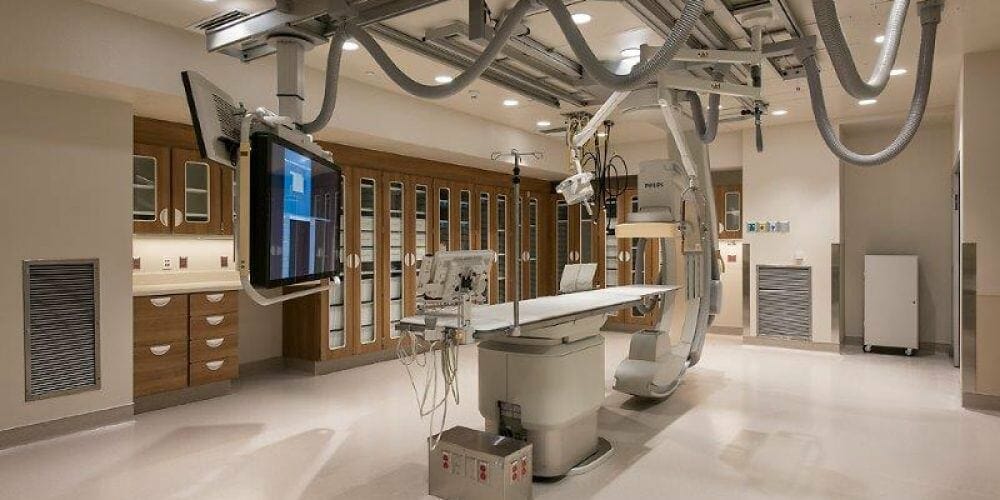Vascular Clinic with Catheterization Laboratory: Minimally Invasive Procedures For Your Vascular Health
Are you experiencing leg pain, vein disease, leg ulcers, swelling, and skin discoloration of legs due to venous insufficiency, or blood clotting?
Patients with signs of peripheral artery disease and other vascular diseases are advised for a scheduled cath lab visit by their doctor.
The Catheterization Laboratory (cath lab) or the Angiography Suite is where interventional radiologists and vascular surgeons perform image-guided, minimally invasive procedures to diagnose and treat vascular disease.
This state-of-the-art environment is like an operating room with diagnostic imaging equipment that assists the interventional radiologist during vascular surgeries, diagnosis, and treatment.
Most patients who need a treatment plan and diagnosis for different blood vessel problems and vascular diseases such as deep vein thrombosis, vascular surgery for bothersome varicose veins and spider veins, peripheral arterial disease, and other vascular conditions find the proper care and advanced treatments here.
Procedures Done In Cath Lab To Treat Vascular Diseases
Doctor Matthew Dicker, an Interventional Radiologist and vascular doctor in Prescott said, “The majority of the procedures performed in the Cath Lab are catheter-based, which means that a vascular surgeon or specialist will place a small tube in a blood vessel, through the leg or other body part, to take a picture of it.”
Catheter Based Procedure
Procedures performed using image guidance to treat vascular disease includes:
- Angiography
- Angioplasty or Balloon Angioplasty
- Vertebroplasty
- Uterine fibroid embolization
- Chemoembolization
- Aortic stent-grafts
- Blood clot in lung known as Pulmonary embolism
- Deep vein thrombosis – blood clot forms in deep veins
- Peripheral arterial disease – narrowed arteries that reduce blood flow to limbs.
Non-Catheter Based Procedure
Other diagnosis and treatment options include:
- Placement of implanted devices such as pacemakers or IV media ports.
- Vascular access procedures such as intravenous PICC lines.
- External tubes and drains can also be inserted as needed into the stomach, liver, gallbladder, or kidneys.
Equipment For Diagnosis and Treatment of Vascular Disease
As Dr. Dicker explains, “The main imaging equipment is fluoroscopy or real-time X-ray that provides high-quality images of the vascular system.
That, along with ultrasound and CT scan technology, helps to guide us through blood vessels, blood clots, or organs of interest.
We use various sizes and shapes of wires, catheters, and stents, as well as plaque-busting devices that help us open blockages, deliver medicine, or help a patient receive long-term medication in a way that is minimally invasive, pain free with a shorter recovery time.”
Our trusted team of vascular specialists provides treatment options for a venous disease that would work best and consider the patient’s risk factors to ensure the best care for our patients.
Your Vascular Health Specialists That Provides Top Quality Care

The Vascular and Interventional Specialist of Prescott (VISP) clinic has a warm and welcoming environment.
They also have an attentive and knowledgeable team of nurses, vascular surgeons, technologists, and other healthcare professionals who meet their patients’ and the doctors’ needs every day to help improve their quality of life and their vascular condition.
Dr. Dicker added, “With the excellent treatment by caring and supportive nurses before and after the procedure, the individualized care by the team in the procedure room, and the relatively pain-free procedures, a trip to the Cath Lab doesn’t have to be a scary experience.”
Contact us Vascular and Interventional Specialists of Prescott at (928) 771-8477 if you have questions about the Cath Lab or the Cath Lab experience.
Vascular & Interventional Specialists of Prescott was formed in 2010 by a group of subspecialty radiologists that perform numerous minimally-invasive, low-risk procedures using the tools of our trade for guidance—x-ray, ultrasound, CT scan, and MRI. The team’s goal is to educate patients and medical communities, while also providing safe and compassionate health care, with rapid recovery times and low risk of complications.

